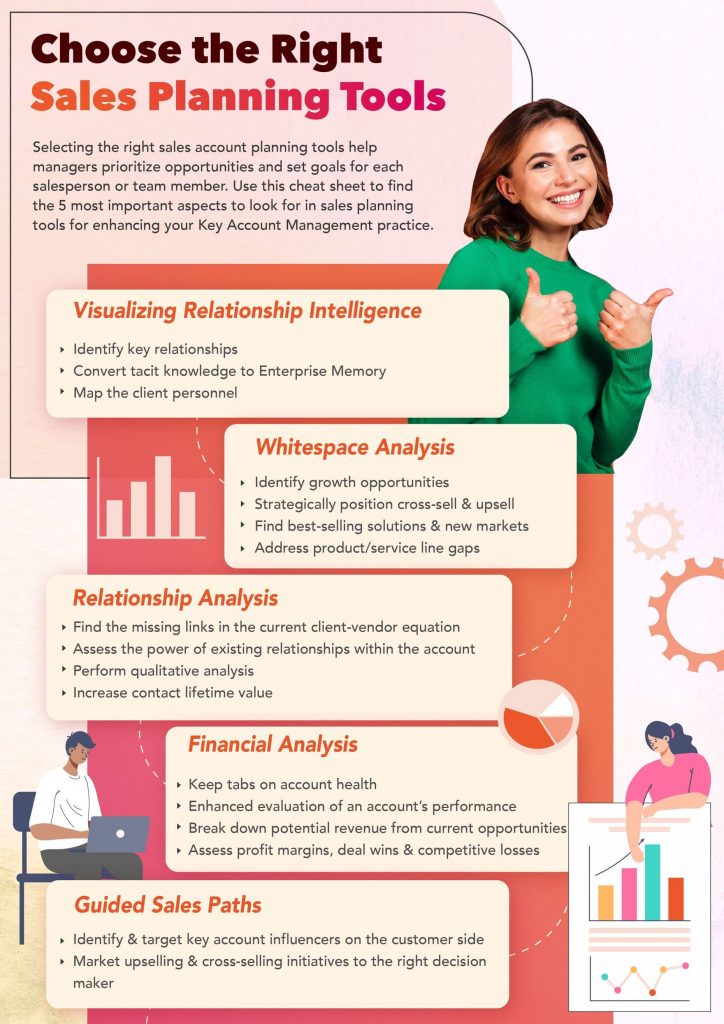A recent study has shown that B2B companies that prioritize customer experience generate higher revenues and profits than those that don’t. One key way to improve the customer experience for your key accounts is through a Digital Key Account Management (DKAM) program. With a well-designed digital Key Account ManageKey Performance Indicatorsment program, you can provide customized and seamless online experiences that drive growth got your business.
However, simply launching a digital Key Account Management program isn’t enough. To truly reap the benefits, you need to measure the effectiveness of your program and optimize it for better performance. But what are the key metrics that B2B companies should be measuring to determine the success of their digital KAM program?
As a sales leader or sales enablement leader, if this is a challenge you’ve been facing you’re in the right place. You’re about to discover actionable insights and key metrics to determine the success of your digital Key Account Management program. By tracking the right data and analyzing it effectively, you can optimize your program for business success.
Download Whitepaper: The Impact of Digital Key Account Management on Sales Enablement
Understanding Digital Key Account Management
Digital Key Account Management is a strategic approach to managing your most valuable customers using digital channels. The main goal of digital Key Account Management is to improve customer experience, build strong relationships, and increase revenue by identifying and satisfying customer needs in a personalized manner.
One of the biggest benefits of digital Key Account Management is that it allows companies to create a more effective and efficient communication channel with their customers. This type of relationship management enables businesses to identify and address customer pain points proactively and deliver customized solutions that meet their unique needs. This not only helps businesses retain their existing customers but also helps them generate more revenue by upselling and cross-selling products and services.
However, implementing a digital Key Account Management program comes with its own challenges, one of the biggest challenges is identifying the right digital tools and strategies to implement the program successfully. Another challenge is ensuring that the Key Account Management team has the right skills and expertise to manage digital channels effectively.
Despite these challenges, digital Key Account Management programs have been successfully implemented in different industries.
For instance, a B2B manufacturing company can implement digital Key Account Management by leveraging digital channels to deliver timely and relevant content to help its customers improve their manufacturing process. Similarly, in a healthcare company digital Key Account Management can be successfully implemented to provide personalized healthcare solutions to its customers – specialized clinics and hospitals – based on the health profiles of the patients they treat and care for.
Advanced digital health tech solutions are increasingly being integrated into these key account strategies, allowing healthcare providers to offer remote monitoring capabilities, personalized treatment plans, and data-driven insights that significantly enhance patient outcomes while creating stronger business relationships with institutional clients.
Technology plays a significant role in enabling digital Key Account Management. There are several tools available to Key Account Management teams to help them manage their relationships with customers effectively. For example, Customer Relationship Management (CRM) tools help Key Account Management teams manage customer data, track customer interactions and create personalized customer profiles.
Other tools such as marketing automation software, social media monitoring tools, and analytics software help Account Management teams deliver personalized content, track customer behavior, and measure the effectiveness of their digital Key Account Management program.
Key Metrics to Measure Success in Digital Key Account Management
Digital Key Account Management can boost revenue and profitability for B2B businesses, but measuring its effectiveness is critical.
Here are some key metrics you should be tracking to evaluate the success of your digital Key Account Management program:
1. Revenue growth:
The primary goal of Key Account Management is to maximize profitability from key accounts, therefore tracking revenue growth is a critical metric to measure success.
Sales leaders can monitor revenue growth by tracking the percentage of revenue generated from key accounts over a given period. By setting revenue targets and analyzing the progress of each account towards that target sales leaders can identify areas that need improvement and take action to optimize sales strategies.
2. Customer retention rate:
In the B2B sector, customer retention is critical to long-term success. Sales leaders can track customer retention rates by measuring the percentage of key accounts that continue to do business with the company over a given period.
This metric provides insight into the effectiveness of the company’s overall sales strategy. It also serves to measure the effectiveness of the Key Account Management program in particular. By identifying accounts that are at risk of churn, sales leaders can take proactive steps to address challenges and retain the account.
3. Customer satisfaction:
This is another important metric to measure the success of a digital Key Account Management program. Sales leaders can track customer satisfaction by using customer feedback surveys, Net Promoter Scores (NPS) and other relevant metrics.
By analyzing the results, sales leaders can identify areas where improvements in the overall customer experience can be made. They can then work with their Key Account Management teams to make necessary changes.
4. Account Engagement:
This measurement of this metric is crucial to the success of a digital Key Account Management program. Sales leaders can track account engagement by monitoring the frequency and quality of interactions between the Key Account Management team and key accounts.
After a thorough analysis of the engagement data sales leaders can identify areas where Key Account Management teams need additional support or training to improve their engagement and overall effectiveness.
By tracking these key metrics and analyzing the results, sales leaders and sales enablement leaders can gain a comprehensive understanding of the success of their digital key Account Management program. They can thus use the data to make better decisions for business success.
Learn More: 6 Key Takeaways for a Successful Key Account Management Transformation Journey
Key Challenges in Implementing Digital Key Account Management
While Digital Key Account Management may be a powerful tool for driving growth and building long-term relationships with your key clients, it has its fair share of challenges. As a sales leader or sales enablement leader, you will probably face a range of hurdles when trying to implement digital Key Account Management effectively.
Alignment between sales and marketing teams:
One of the most common challenges is ensuring that your sales and marketing teams are aligned in their approach. Without clear communication and collaboration between these two departments, you may struggle to deliver a seamless customer experience and nurture relationships effectively.
To overcome this challenge, it’s important to invest in cross-functional training, encourage regular meetings between your sales and marketing teams, and establish shared ethics and goals that everyone can work towards.
Choosing the right technology:
With so many tools and platforms available, it can be overwhelming to determine which ones are best suited to your needs. To make the right choice, you’ll need to consider factors such as your budget, the level of customization you require and the specific features that will help you achieve your goals. It may also be helpful to consult with external experts or trusted vendors who can provide guidance and support as you navigate the complex landscape of sales technology.

Building a customer-centric culture:
This is critical to the success of your digital Key Account Management program. The success of your business is dependent on your customers. It is therefore essential to put their needs and preferences at the centre of all your plans and strategies.
This means developing a deep understanding of their pain points, priorities and goals. You can then use this knowledge to tailor your interactions and offerings accordingly.
It also means creating a culture of empathy and customer-centricity throughout your organization. This orients all your teams towards delivering a superior customer experience.
By proactively addressing these challenges and implementing effective strategies for overcoming them, you can position your organization for success in the dynamic world of digital Key Account Management.
Best Practices for Implementing Digital Key Account Management
Digital Key Account Management can be a game-changer for businesses, but implementing it successfully requires a strategic approach. Here are some best practices for implementing a successful digital Key Account Management program:
Firstly, it’s important to set clear goals and objectives for your digital KAM program. Identify what you want to achieve with your Key Account Management program and align these goals with your business objectives. For instance, if your objective is to increase customer retention, your Key Account Management program should focus on improving customer relationships.
Defining Key Performance Indicators (KPIs) is also crucial to measure the success of your Key Account Management program. These KPIs can vary depending on your goals, but some common metrics include customer retention rate, revenue growth and customer satisfaction.
Additionally, establishing a regular review process is important to ensure that your digital Key Account Management program is on track and meeting its goals. Regular reviews can help identify any areas for improvement and ensure that the program remains relevant and effective.
Let’s take a look at successful digital Key Account Management programs in different industries. For example, a software company can implement a digital Key Account Management program that is focused on building strong relationships with its top customers. They could provide personalized support and access to exclusive resources. This will help increase their customer retention and revenue growth.
Manufacturing companies can also use a digital Key Account Management program to improve customer satisfaction. In this case, technology can be leveraged to provide real-time updates on order status and delivery. Through this, the company can improve its customer satisfaction rating and establish long-term relationships with its key accounts.
Implementing a successful digital Key Account Management strategy requires a strategic approach and a commitment to customer-centricity. By setting clear goals, defining KPIs, establishing a review process, and learning from successful examples leaders can take their digital Key Account Management program to the next level.
KPIs For Measuring the Effectiveness of Digital Key Account Management
Key Performance Indicators (KPIs) are critical for measuring the effectiveness of digital Key Account Management. KPIs provide businesses with a quantifiable way to measure the success of their Key Account Management programs, allowing them to track their progress, identify areas of improvement, and make data-driven decisions.
Some of the essential KPIs that businesses can use to measure the effectiveness of their digital Key Account Management programs are:
1. Customer Lifetime Value (CLV):
The amount of revenue a customer is expected to generate over their lifetime with a business. It’s a crucial metric that helps businesses understand the long-term value of their customers and their impact on the bottom line.

2. Customer Acquisition Cost (CAC):
The cost associated with acquiring a new customer. It includes all expenses incurred in the process of acquiring a new customer such as advertising, marketing and sales costs. A low CAC is essential for a sustainable business model, as it allows businesses to acquire new customers cost-effectively.
3. Customer Churn Rate:
The percentage of customers that stop doing business with a company over a given period. It is a critical metric that helps businesses understand the attrition rate of their customer base. A high churn rate could indicate a problem with the company’s offering or its customer relationship management practices.
4. Customer Satisfaction (CSAT) Score:
A measure of how satisfied customers are with a company’s products or services. It’s typically measured using a survey that asks customers to rate their satisfaction on a scale. A high CSAT score indicates that customers are happy with the company, which is essential for customer retention and loyalty.
5. Net Promoter Score (NPS):
A metric that measures the likelihood of customers recommending the company’s products or services to others. This score is also measured through a survey. High scores indicate that customers are loyal and willing to promote the brand.
6. Sales Growth:
The percentage of increase or decrease in revenue over a given period. It’s a critical metric that helps businesses understand the effectiveness of their Key Account Management programs in driving revenue growth. A negative sales growth rate indicates that changes need to be made in the company’s Key Account Management program.
7. Engagement Metrics:
A measure of how customers interact with a company’s digital offerings, such as website traffic, click-through rates, and social media engagement. These metrics help businesses understand the effectiveness of their digital marketing efforts and can be used to optimize their Key Account Management strategies.
These KPIs provide businesses with valuable insights into the effectiveness of their digital Key Account Management programs. With this information, they can identify areas of improvement, and make decisions to improve customer engagement and loyalty. Thus advancing business goals and scaling business operations.
How DemandFarm is Revolutionizing Digital Account Planning
DemandFarm has all the tools you require for digital Key Account Management. But they do more than this. They are a consultative partner providing expertise and guidance throughout the entire account planning journey.
They take an assertive approach, intervening when they see clients relying on outdated processes. They help clients optimize their Key Account Management processes with agility and configurability.
DemandFarm understands that with volatility and regular changes in the market, the traditional template-driven approach is no longer enough. Using data-driven analysis and planning, they help organizations make a transition – through a modular, progressive and phased approach to digital Key Account Management transformation. Check out The Shift Podcast series on the challenges and benefits of transitioning to Digital Key Account Management from sales leaders, account managers and thought leaders world-wide.
Listen to The Shift: #1 Podcast on Digital Key Account Management
Their products are customizable to accommodate the differences across industries, account size and maturity. They also integrate with various platforms and apps while ensuring two-way data flow and security.
Bottom-line!
A digital Key Account Management program is an effective way for B2B companies to improve customer experience, build strong relationships, and increase revenue. To measure the success of a digital Key Account Management program, B2B companies should track metrics such as revenue growth, customer retention rate, customer satisfaction, and account engagement.
By analyzing the data obtained from tracking these metrics, sales leaders and sales enablement leaders can gain a comprehensive understanding of the effectiveness of their digital Key Account Management. They can thus take proactive steps to optimize it for better performance.
Implementing a digital Key Account Management program comes with challenges. Some of these include identifying the right digital tools and strategies, and ensuring the Key Account Management team has the right skills and expertise. However, the benefits of a well-designed program outweigh the challenges.
With the right approach and tools, B2B companies can use digital Key Account Management to drive success and growth.
 On-Demand Webinar: Unfiltered take on AI in Account Planning: Meet DemandFarm’s KAM AI
On-Demand Webinar: Unfiltered take on AI in Account Planning: Meet DemandFarm’s KAM AI 


